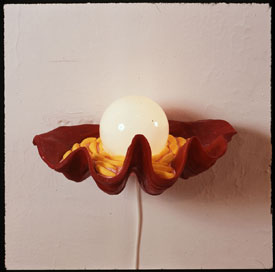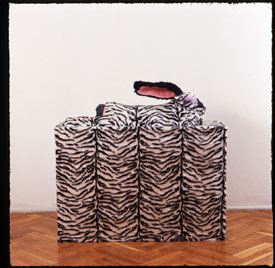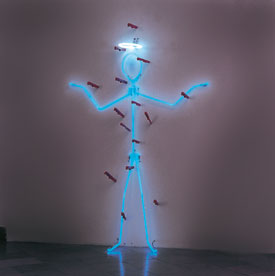MAREK KIJEWSKI – I am all a-tremble when I can shower you with gold
The title of Marek Kijewski’s retrospective exhibition I’m all A-tremble When I Can Shower You With Gold (Drżę więc cały, gdy mogę was ozłocić) is borrowed from the 1987 action at Dziekanka Workshop in Warsaw. During this action Marek mounted a motorbike, as if trying to ride away, but initially stalled the engine. After several failed attempts he turned on the headlights and sprayed the bike and people around it with cloud of golden dust. The bike was immobilized, but the whole happening held an enormous dynamic potential and accumulated energy. Marek searched for energy all his life, and drew it from many different springs, sometimes even poisoned. His life was consistent with art, or, perhaps conversely, his art was consistent with life. In art, as in life, Marek looked for ways to create tension, currents, short circuits, to change the potential and to release energy.
The preparations for the current Marek Kijowski retrospective reveal that a huge majority of his works from the late 80s and early 90s no longer exist. Lost are not only the works made of perishable, “temporary” materials, created for appearances of Neue Bieremiennost’ Consciousness, of which Marek was co-originator. There is also no trace of the objects presented at his early one-man shows, although these were made of more solid materials: mock-stone, wood, metal. These works were preserved only in the form of documentation: photographs, transparencies and videos, which have thus become legitimate narrative components of the exhibition space.
Marek Kijewski’s works from the Neue Bieremiennost period characterized by a veritable technical bricolage, indicative of free and creative mind which jumbled orders and hierarchies, strategies of surprise and transference, which retained a distrustful and ironic distance toward eroded symbols, aesthetic rules, philosophical and ideological discourses, and which was at the same time fully conscious of the current political and cultural context – in short, presented the typical features also of the artist’s later works.
In the early 90s, Marek strived for a completely different kind of expression, obtained by reduction and minimalization involving the use of primary forms (the square, the circle, the cross) and elementary materials (stone, wood, metal). Light, as a basic elementary substance, also played a crucial role at that time. Marek was attracted to its dual nature, both physical and metaphysical, as he became increasingly interested in the esoteric tradition, gnosis, Rudolf Steiner’s antroposophy, and Paweł Floreński’s mysticism of the icon. Light in his works took mainly the shape of neon signs, often combined with stone, glass or metal structures.
These New concise forms gained fresh meanings especially in juxtaposition with textual matter, which since 1992 became an inherent part of Kijewski’s works and shows. Initially there was a single “universal text”, a quote from Floreński’s Iconostasis and Other Sketches (Ikonostas i inne szkice) concerning the colours of light. Later projects were equipped with individual texts, providing a significant hint to their interpretation. Around that time Kijewski started infusing his works with “hidden values”, components and elements invisible from the outside, brought to the viewer’s awareness only through texts informing about the employed materials.
The artistic development of Marek Kijowski is notable for its cycles and alternating rhythm. He wrote I think my brain works according to five- or six-year plans…”. Sometime around mid-1994 he came to the conclusion that the theme of primary forms in his art has temporarily been exhausted and that the times now had a different “taste”. The shared experience of capitalism and consumption drew his attention to the vivid extravagance of pop culture, and he decided to incorporate its colours in his sculptures.
Searching for a way to reconcile contradictions, attempting to communicate by travelling the labyrinths of culture, discovering syncretic relationships, decoding old meanings while creating new codes – all these tendencies found most vivid expression in the works of the Kijewski/Kocur from the late 1990’s. Małgorzata Malinoska/Kocur was then Marek Kijewski’s life and artistic partner. It was then they developed the SSS theory – surfing, scanning, sampling – providing unusual possibilities for intellectual and artistic endeavour. The artists surfers, moving freely over space of culture, and over past, present and imagined future time, scanned some selected, useful motives or elements, and sampled them to create new hybrid art, attuned to the sensibility of postmodern men and women.
Around the year 2000 Kijewski again came to know what he expected from primary forms. Duo Kijewski/Kocur proceeded to develop a system of Ethical Bits, relating to the dichotomies of good/evil, mind/matter, and visual constructions which represent them. Bits, the smallest elements of computer space, where combined in this system with the colour symbolism adopted by the Orthodox Church, Malevich’s suprematism and the colour gold representing energy. Kijewski intended the Ethical Bits language to aid our passage into the world of new spirituality (third millenium).
Marek Kijewski knew precisely what art means for him and how it relates to life. In his graduation thesis in 1985 he quoted from Claes Oldenburg’s manifesto, which he took for his own even then: “I am for an art that is political-erotical-mystical that does something other than sit on its ass in a museum (…). I am for an art that takes its form from the lines of life itself, which twists and extends and accumulates and spits and drips, and is heavy and coarse and blunt and sweet and stupid as life itself.”*
*C. Oldenburg, 1961, cf. M.Kijewski, Mity i rzeczywistość, rękopis pracy magisterskiej / [Myth and realisty, graduation thesis manuscript], ASP, Warszawa, 1985

PLAN YOUR VISIT
Opening times:
Thuesday – Sunday
10:00-18:00
Last admission
to exhibition is at:
17.30




